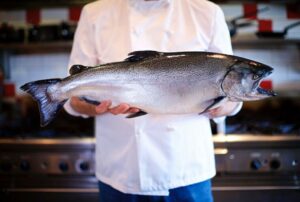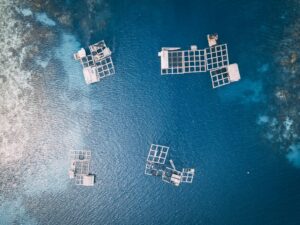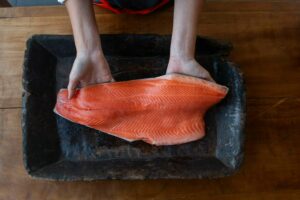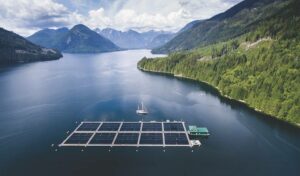Is BC Farm-Raised Salmon Safe?
A frequently asked question we hear is whether BC farm-raised salmon is safe for consumption. This article seeks to detail how safe it is to consume salmon farmed in BC, contributing to our mission of advancing public comprehension and confidence in the BC salmon aquaculture sector.

How is salmon farmed in British Columbia?
Broodstock
- The process often begins with the broodstock, who are the parents of the next generation of salmon
- Salmon farmers in BC have specific fish selected to be the broodstock and have their own ocean pens where they live.
Hatcheries and Smolt Production
- Following the collection of salmon eggs from the broodstock, they are fertilized and hatched into alevins at the hatchery
- Once the alevins reach a certain stage of development, they are known as smolts
- Smolts are then vaccinated and tested to ensure they are healthy before being transferred to ocean pens for the next stage of their life cycle
Ocean Pens
- The majority of salmon farming in BC takes place in ocean pens, which are large floating structures in coastal waters
- These pens are designed to contain the fish while allowing for water exchange and natural ocean currents to flow through

Feeding and Growth
- Salmon are fed a nutritious diet to support their growth. The feed is typically comprised of 30 to 45 percent alternative proteins (eg. poultry or plants), 12 to 20 percent alternative oils (eg. canola or flax), 2 to 16 percent fish meal, 10 to 15 percent binders and carbohydrates, 10 to 15 percent fish oil, 2 to 5 percent water, 4 to 6 percent micronutrients (eg. vitamins and minerals)
- Monitoring and managing the health of the fish is crucial, and farmers may use technology such as underwater cameras and sensors to assess conditions in the pens
Environmental Monitoring
- BC salmon farmers are required to adhere to strict regulations regarding environmental impact. Monitoring water quality, sea lice levels, and other factors helps ensure sustainable farming practices
Harvesting
- Salmon are typically harvested when they reach market size, which can take up to three years, depending on the species
- During harvesting, fish are removed from the pens, humanely euthanized and transported to processing facilities by boat
Processing and Distribution
- Once harvested, salmon are transported to processing facilities where they are cleaned, fileted, and prepared for distribution
- Processed salmon is then distributed to markets, both domestically and internationally
It’s important to note that salmon farming practices are subject to rigorous regulations and guidelines to minimize environmental impact and ensure the health and safety of both the fish and consumers. The sector continues to evolve, with ongoing efforts to adopt sustainable practices and address environmental concerns.
Is farm-raised salmon in BC safe?
Yes, farm-raised salmon from British Columbia, Canada, is considered safe for consumption! The salmon farming sector in BC adheres to rigorous regulations and standards set by government authorities to ensure the safety and quality of the products. Here are some key points regarding the safety of BC farm-raised salmon:
Regulatory Oversight
- The BC salmon farming industry is subject to strict regulations and oversight by regulatory agencies, including Fisheries and Oceans Canada (DFO) and the Canadian Food Inspection Agency (CFIA)
- https://news.gov.bc.ca/factsheets/salmon-aquaculture-in-british-columbia
- These agencies set standards for water quality, feed composition, disease management, and other aspects of salmon farming to ensure compliance with safety and environmental requirements
Monitoring and Testing
- Farmed salmon undergo regular monitoring and testing for contaminants, including heavy metals, pesticides, and pollutants
- The CFIA and other regulatory bodies conduct inspections and testing to verify that farmed salmon meet established safety standards
Food Safety Practices
- Salmon farming operations in BC implement food safety practices to minimize the risk of contamination during the production, processing, and distribution stages
- Processing facilities follow strict hygiene and quality control measures to ensure that the final product is safe for consumers
Antibiotic Use and Chemicals
- BC salmon farmers have reduced the use of antibiotics and other chemicals in response to concerns about their potential impact on human and fish health and the environment
- The use of veterinary drugs is regulated, and fish health management practices, including vaccines, aim to minimize the need for antibiotics
Traceability
- The industry emphasizes traceability, allowing consumers to track the source of the salmon they purchase. This transparency helps ensure accountability and builds trust in the safety of farmed salmon
Farmed Salmon: A healthy, environmentally friendly food source
While BC farm-raised salmon is considered safe, consumers should still follow standard food safety practices when preparing and cooking salmon. Additionally, individuals with specific health concerns or dietary restrictions should consult with healthcare professionals for personalized advice. Overall, BC’s salmon farming industry is committed to producing safe and sustainable seafood through responsible practices and continuous improvement.

Representing over 60 businesses and organizations involved in the finfish aquaculture value chain in British Columbia, the BC Salmon Farmers Association (BCSFA) is dedicated to offering informative resources to the public and stakeholders regarding salmon farming in the province. Our objective is to enhance public awareness and foster trust in the sector across diverse communities, ranging from North Vancouver Island, such as Campbell River and Port Hardy, to other areas on Vancouver Island, such as Tofino, Nanaimo, and Victoria, to mainland cities like Vancouver and Kelowna, extending all the way to the national capital in Ottawa.
